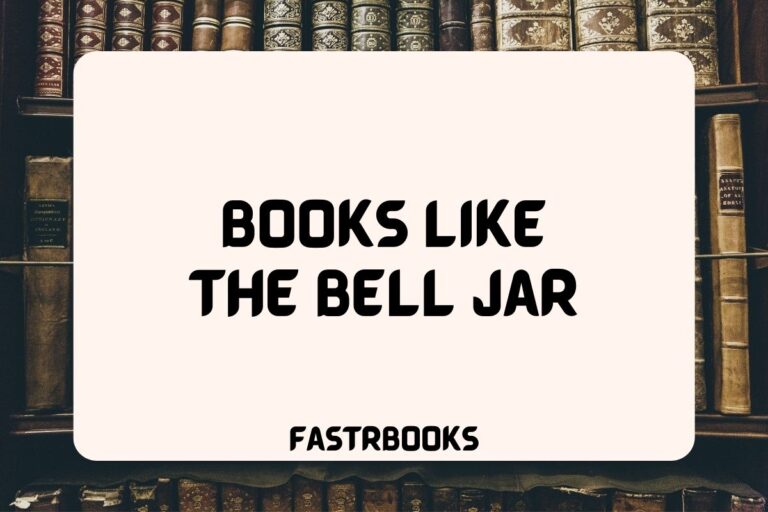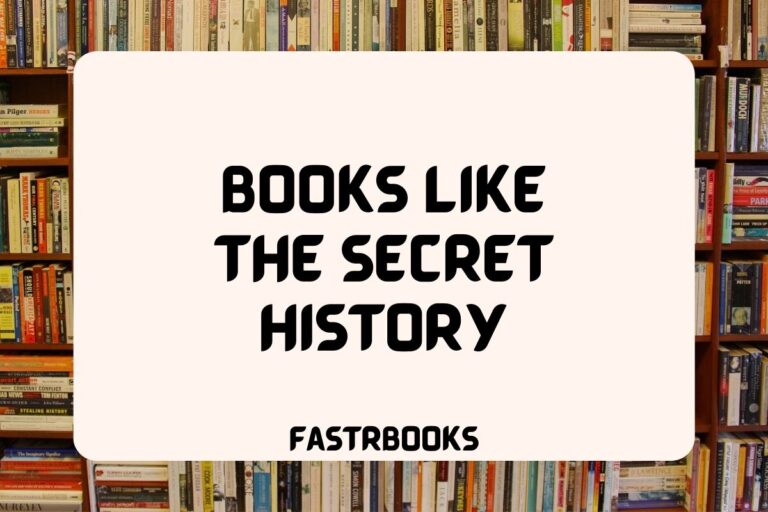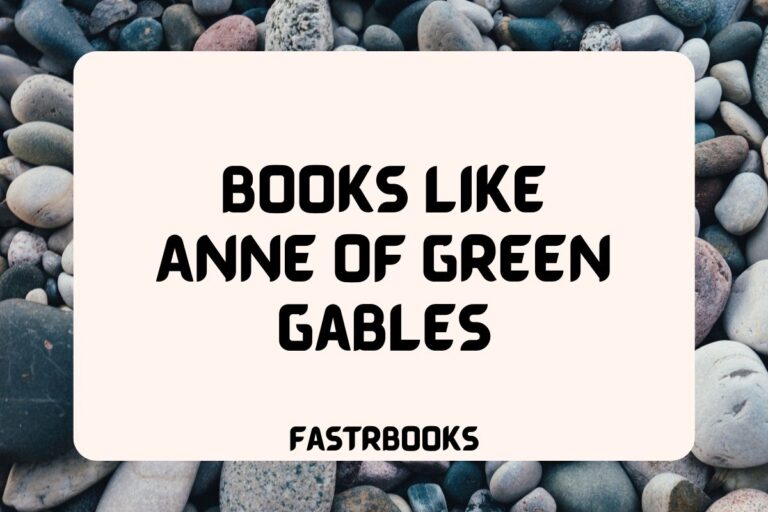14 Books Like Fahrenheit 451
Have you ever read a book that ignited a fire within you, not just in your imagination, but in your soul?
A book that made you question the very fabric of society, its values, and the consequences of its actions?
If so, you might understand the profound impact of Ray Bradbury’s masterpiece, “Fahrenheit 451.” This iconic novel, with its chilling portrayal of a dystopian future where books are banned and burned, has left readers both mesmerized and unsettled since its publication.
But what if you’ve devoured every word of “Fahrenheit 451” and hunger for more tales that spark similar introspection and contemplation?
Well, this list will do the justice for you.
Let’s begin.
Books Like Fahrenheit 451
1. 1984 by George Orwell
“1984” is a dystopian novel that presents an oppressive world governed by the Party, led by the mysterious Big Brother.
The protagonist, Winston Smith, works for the government in the Ministry of Truth, where his job is to alter historical records to fit the Party’s propaganda. The narrative explores themes of surveillance, government control, individual freedom, and the nature of truth.
Orwell’s vision of a world where critical thought is suppressed under a totalitarian regime has made this novel a fundamental text for discussions on freedom, truth, and privacy.
Major Similarities:
Both “1984” and “Fahrenheit 451” explore themes of censorship, the suppression of dissent, and the control of information by a totalitarian regime. They depict societies where the government exercises extreme control over individuals’ lives, including their thoughts and actions.
The use of technology to monitor and manipulate citizens is a critical element in both novels, highlighting concerns about the loss of privacy and freedom. Each book serves as a cautionary tale about the dangers of unchecked governmental power and the importance of intellectual freedom.
2. Brave New World by Aldous Huxley
Set in a futuristic world state where citizens are engineered into an intelligence-based social hierarchy, “Brave New World” explores the cost of state-controlled happiness.
The narrative follows Bernard Marx and John the Savage, who challenge the foundations of their society’s values. Themes of technological advancements, societal conditioning, the use of recreational drugs to maintain social order, and the suppression of individuality are prevalent.
Huxley’s novel presents a vision of a utopian society with dystopian elements, where true freedom and human emotions are sacrificed for stability and societal harmony.
Major Similarities:
“Brave New World” and “Fahrenheit 451” share a critical view of future societies where governments control every aspect of individuals’ lives, including their thoughts, emotions, and desires.
Both novels depict a world where literature and critical thinking are suppressed to prevent dissent and maintain social order.
The concept of using technology and other means to manipulate and control the population is central to both stories, raising questions about the role of government in personal lives and the value of individuality versus societal harmony.
3. The Handmaid’s Tale by Margaret Atwood
This novel is set in the dystopian future of the Republic of Gilead, where a theocratic regime has overthrown the United States government. The story is told through the eyes of Offred, a Handmaid who serves in the household of a high-ranking official, Commander Fred Waterford.
In this society, women are stripped of their rights and roles are strictly defined. The novel explores themes of power, gender dynamics, resistance, and the use of religion to justify oppressive government policies.
Atwood’s rich narrative provides a chilling exploration of the consequences of extremism and the loss of individual rights.
Major Similarities:
Similar to “Fahrenheit 451,” “The Handmaid’s Tale” portrays a society where an authoritarian regime controls knowledge, suppresses freedom of expression, and enforces conformity through draconian laws.
Both books examine the effects of government control over personal lives and the importance of resistance against oppressive systems.
The themes of censorship, the role of literature (or its absence), and the struggle for individual autonomy against societal constraints are prominent in both narratives, making them resonate with readers concerned about the erosion of civil liberties.
4. We by Yevgeny Zamyatin
“We” is a pioneering work in the dystopian genre, set in the One State, governed by the Benefactor and regulated by a set of strict rules and surveillance. The citizens, known by numbers instead of names, live in a society where free will is considered the cause of unhappiness, and individuality is eradicated in favor of the collective.
The protagonist, D-503, begins to question the principles of the One State after falling in love. Zamyatin’s novel delves into themes of freedom, surveillance, and the conflict between the individual and the collective, prefiguring many of the concerns of later dystopian works.
Major Similarities:
Both “We” and “Fahrenheit 451” explore the suppression of individuality in favor of a conformist society under the guise of maintaining order and happiness. Each narrative confronts the dangers of a government that seeks to control every aspect of life, including thoughts, emotions, and relationships.
The central themes of rebellion against an oppressive regime, the pursuit of knowledge, and the right to individual thought and expression link these two novels closely, offering a critique of societies that prioritize conformity over personal freedom.
5. A Clockwork Orange by Anthony Burgess
“A Clockwork Orange” is set in a dystopian future society and follows the story of Alex, a delinquent teenager who revels in acts of ultra-violence and crime. After being captured, Alex is subjected to an experimental psychological conditioning process aimed at reforming criminals by removing their ability to make choices about good and evil.
The novel raises questions about free will, the ethics of forced rehabilitation, and the nature of evil. Burgess’s use of a fictional slang language, Nadsat, adds a unique layer to the narrative, immersing the reader in Alex’s perspective.
Major Similarities:
Both “A Clockwork Orange” and “Fahrenheit 451” challenge the notion of governmental control over individual morality and the consequences of suppressing free will.
While “Fahrenheit 451” focuses on the control of information and intellectual freedom, “A Clockwork Orange” examines the moral implications of removing an individual’s capacity to choose between good and evil.
Themes of resistance, the importance of individual choice, and the critique of using technology and psychological manipulation as tools of control are central to both novels, presenting a dystopian vision where societal attempts to create a “perfect” world result in profound ethical and moral dilemmas.
6. The Giver by Lois Lowry
“The Giver” is set in a seemingly utopian society where pain, suffering, and choice have been eliminated to ensure sameness and harmony. The protagonist, a young boy named Jonas, is selected to be the Receiver of Memory, the individual who stores all the past memories of the time before Sameness.
As Jonas receives these memories from the Giver, he becomes aware of the depth of human experience that has been sacrificed for the sake of societal stability.
This realization leads him to question the values of his community and the cost of their enforced utopia. Lowry’s novel explores themes of memory, individuality, and the importance of human emotions.
Major Similarities:
Like “Fahrenheit 451,” “The Giver” deals with the suppression of knowledge and history to maintain control over a society. Both novels explore the consequences of a government’s attempt to create a conflict-free world by eliminating complex human experiences and emotions.
The themes of awakening and rebellion against a conformist society are central to both stories, as the protagonists come to recognize the value of individual thought and the richness of life outside the constraints of their oppressive environments.
7. Parable of the Sower by Octavia E. Butler
Set in a future America where society has collapsed due to climate change and economic hardships, “Parable of the Sower” follows the journey of Lauren Olamina, a young woman who possesses a unique empathetic ability.
As she navigates a dangerous and chaotic world, Lauren conceives a new philosophical and religious movement called Earthseed, aimed at fostering a community that can adapt and thrive amidst the hardships. The novel is a deep exploration of survival, community building, and the resilience of the human spirit in the face of societal breakdown.
Butler’s work combines elements of science fiction with poignant social commentary, reflecting on issues of environmental degradation, social inequality, and the human capacity for both destruction and innovation.
Major Similarities:
“Parable of the Sower” and “Fahrenheit 451” both feature protagonists who question the status quo and envision a different future for themselves and their societies.
While “Fahrenheit 451” focuses on the suppression of books and knowledge to control society, “Parable of the Sower” deals with the broader themes of societal collapse and the necessity of adaptability and resilience.
Both novels highlight the importance of knowledge, community, and the pursuit of a better world in the face of oppressive conditions, underscoring the power of individual action and thought in challenging and changing dystopian realities.
8. The Dispossessed by Ursula K. Le Guin
“The Dispossessed” presents a tale of two contrasting planets: Urras, rich and capitalist, and Anarres, a barren world where inhabitants live according to anarchist principles.
The protagonist, Shevek, is a brilliant physicist from Anarres who challenges the ideological and physical barriers between the two worlds in his quest for scientific and social progress. Through Shevek’s journey, Le Guin explores themes of freedom, society, and the individual’s role in a community.
The novel is celebrated for its deep philosophical inquiry into the nature of anarchism, capitalism, and the possibility of a truly free society.
Major Similarities:
Both “The Dispossessed” and “Fahrenheit 451” explore themes of freedom, censorship, and the individual’s quest for truth in societies with contrasting ideologies.
While “Fahrenheit 451” focuses on the suppression of books and intellectual freedom, “The Dispossessed” examines the broader implications of political and ideological control on scientific and social progress.
The protagonists of both novels embark on journeys of self-discovery that challenge the foundations of their respective worlds, highlighting the importance of critical thinking and the pursuit of knowledge as acts of resistance against conformity and oppression.
9. V for Vendetta by Alan Moore and David Lloyd
“V for Vendetta” is a graphic novel set in a dystopian future United Kingdom, which has fallen under the rule of a fascist regime. The story follows V, a mysterious anarchist vigilante who wears a Guy Fawkes mask and seeks to overthrow the government through elaborate acts of terrorism and propaganda.
Through V’s interactions with Evey Hammond, a young woman he takes under his wing, the narrative explores themes of freedom, resistance, and the power of ideas. Moore and Lloyd’s work is a compelling examination of the struggle against tyranny and the importance of individual rebellion in the face of oppressive systems.
Major Similarities:
“V for Vendetta” shares with “Fahrenheit 451” a profound concern with censorship, state control, and the suppression of dissenting ideas. Both stories feature protagonists who stand against the prevailing order, risking everything to awaken their fellow citizens to the truths hidden by their governments.
The emphasis on the transformative power of literature, the arts, and free thought in combating authoritarianism links these works, underscoring the enduring relevance of Bradbury’s themes in the modern world.
10. Never Let Me Go by Kazuo Ishiguro
Set in a dystopian version of England, “Never Let Me Go” follows the lives of Kathy, Tommy, and Ruth, who grow up at a seemingly idyllic boarding school called Hailsham.
As they mature, they gradually uncover the dark truth about their existence and the purpose behind their upbringing. Ishiguro’s novel is a haunting exploration of memory, loss, and the human capacity for love and betrayal.
It delves into ethical questions surrounding scientific advancement, the nature of the soul, and what it means to be truly human.
Major Similarities:
Like “Fahrenheit 451,” “Never Let Me Go” presents a society where underlying truths are kept from the populace to maintain a veneer of stability and happiness. Both novels explore themes of identity, memory, and the consequences of societal attempts to control or redefine humanity.
The characters’ gradual awakening to the realities of their worlds and their struggles with conformity, personal agency, and the pursuit of meaning echo the journey of Montag in “Fahrenheit 451.”
The moral and ethical questions raised by both authors prompt readers to reflect on the value of individuality and the human condition in the face of technological and societal manipulation.
11. Station Eleven by Emily St. John Mandel
“Station Eleven” weaves together the stories of several characters before and after a devastating flu pandemic wipes out most of the world’s population.
The narrative centers around the Traveling Symphony, a group of actors and musicians who perform Shakespeare and classical music for the scattered settlements of survivors.
Through their journey, the novel explores themes of art, memory, and the resilience of the human spirit in the face of catastrophe. Mandel’s work is a reflection on civilization, the importance of culture, and the connections that bind humanity together across time and space.
Major Similarities:
Similar to “Fahrenheit 451,” “Station Eleven” presents a post-apocalyptic world where survivors cling to the remnants of culture as a means of preserving their humanity.
Both novels explore the significance of art and literature in maintaining a connection to the past and fostering hope for the future.
The importance of memory and storytelling as acts of resistance against the erasure of identity and history links these works, emphasizing the role of creative expression in challenging times.
12. The Road by Cormac McCarthy
“The Road” follows the harrowing journey of a father and his young son as they traverse a post-apocalyptic landscape, devastated by an unspecified cataclysm.
The novel is a stark, powerful meditation on survival, love, and the enduring bond between parent and child in a world stripped of all but the most essential human experiences.
McCarthy’s minimalist prose and the bleakness of his vision highlight the fragility of civilization and the resilience required to sustain hope and morality in the face of utter despair.
Major Similarities:
Both “The Road” and “Fahrenheit 451” depict societies that have undergone catastrophic change, leading to profound reflections on the value of human knowledge and the artifacts of culture.
While “Fahrenheit 451” focuses on the suppression and destruction of books, “The Road” presents a world where the remnants of the old world are precious and rare.
The themes of survival, the importance of memory, and the transmission of knowledge across generations are central to both narratives, offering a poignant look at the role of literature and human connection in preserving our humanity.
13. The Circle by Dave Eggers
“The Circle” is a contemporary dystopian novel that explores the dark side of technology and social media through the story of Mae Holland, a young woman who starts working for The Circle, a powerful tech company.
As she becomes more entwined with the company’s vision of total transparency and surveillance, Mae confronts the consequences of a society where privacy is abolished in favor of an open, monitored world.
Eggers’ novel is a critique of the digital age, questioning the costs of connectivity and the erosion of individual freedoms in a world dominated by social media.
Major Similarities:
“The Circle” and “Fahrenheit 451” both deal with themes of surveillance, privacy, and the control of information.
While “Fahrenheit 451” presents a government that controls and censors information through the burning of books, “The Circle” explores a society where technology enables unprecedented levels of surveillance and manipulation.
Both novels warn of the dangers of allowing any entity, whether it be a government or a tech company, to dominate the landscape of knowledge and communication, highlighting the importance of critical thinking and the preservation of personal privacy.
14. This Perfect Day by Ira Levin
“This Perfect Day” is a lesser-known but equally compelling dystopian novel that depicts a world controlled by a single, all-powerful computer named UniComp.
This centralized authority dictates every aspect of human life, from birth to death, ensuring that individuality is suppressed in favor of a homogenized society. The protagonist, Chip, gradually becomes aware of the lies that underpin the facade of utopian society and joins a group of rebels seeking to dismantle the system.
Levin’s narrative delves into themes of freedom, individuality, and the human desire for autonomy against a backdrop of total control.
Major Similarities:
Like “Fahrenheit 451,” “This Perfect Day” explores the consequences of a society that has sacrificed individual freedom and diversity for the sake of order and uniformity.
Both novels present central characters who awaken to the realities of their controlled environments and seek to challenge the systems that suppress true human expression.
The struggle against a seemingly benevolent but ultimately oppressive authority, the value of dissent, and the pursuit of knowledge and freedom are key themes that resonate in both works.






